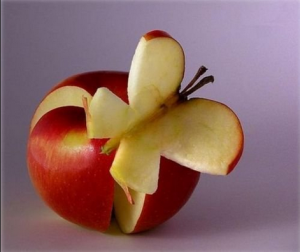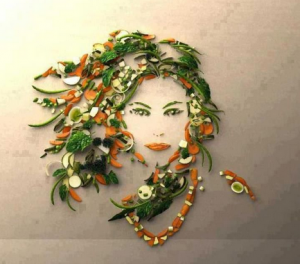Objectives:
- Examine methods for evaluating qualities of art
- Explore the notion of food as an art-form
- Consider cultural differences in the production and consumption food
Artifact #3: Is Food Art?
Dersesiewicz, W. (2012, October). A Matter of Taste? [On-line article] Retrieved October 25, 2013 from http://www.nytimes.com/2012/10/28/opinion/sunday/how-food-replaced-art-as-high-culture.html
I did my research on the article “A Matter of Taste?” written by William Deresiewicz. In the article, the author describe how food related to art, but also provide his own opinion that food can not be an art. To build the main point, William first introduced how food related to art and why foodlism believed that food was replacing art. William mentioned that new creation of taste would lead to a taste for art. (William, 1) Then, William described several similar characteristics of food related to arts. Like art, people also like to share food with their friends. Like art, food was developed to things that related to culture, education, entertainment, politics, religious and many other fields. After explaining why food was related to art, William produced his own perspective toward when food is art. He provided two main reasons that why he said food is not art. William believed that food is not narrative or representational and food does not express emotion. William also provided some examples to support his point and in his conclusion, he agreed the importance of food in human life, but against that food is an art.
Comparing with the Tefler’s essay “Food as art”, William’s article has several similar point related to Tefler’s essay. First, both of the two articles describe how creation and combination of taste lead food toward an art. In Tefler’s article, she stated “I conclude that there are no limitations, in us or in the nature of tastes themselves, which prevent food from giving rise to works of art in the evaluative sense of that phrase though these will be simpler than in the arts of sight and sound.(Tefler, 22) She believed that without limitations of taste, it would rise works of food toward arts. William produced similar opinion related to taste in his first paragraph that creation of taste for food would lead to a taste for art.(William, 1) Second, both of the articles, mentioned that food can be shared with other people and different people might have different feelings and reactions, just like people would share their different views toward arts. Tefler stated that people would share the same dish of food and appreciate them together, but different people would eat different parts of the dish and they may have different opinions toward the same dish.(Tefler, 17) William also talked about sharing food with other people like people share arts with other people. Third, both of the articles admitted that food is not representational. Tefler stated that “To begin with, food does not represent anything else, as most literature and much visual art does.” (Tefler, 25) William also stated that both food and art can address senses, but art can do a lot more than food. He used apple as an example to support his opinion that apple is not a story, even if we can tell a story about it.
Both of the article also have several different opinions toward whether food is art. First, William believed that arts need to be narrative or representational and food cannot fulfill this requirement, so food is not art. However, Tefler stated in her article that “It might be said with justice that an art does not need to be representation in order to be a major art.” (Tefler, 25) Tefler used music as an example that music does not represent the world so much as create another world of its own. But most of people will view music as a type of art. I agree with Tefler’s idea, because I do not think anything that representational could be art. For example, a user guide on the cover of a type of cooking source shows how to use the source which is representational, but most likely not art. In addition, sometimes, food can be representational. For example, different Chinese food can represent different culture and place in China such as spicy food can represent food from Sichuan.
Second, William stated that food does not express emotion but art does, so food is not art. However, Tefler stated “The inability of food to express emotion does not mean that cooks cannot express themselves in their work.” (Tefler, 26) William believed that food can evoke emotions, but only very roughly and generally, and only within a very limited range such as comfort and delight, but not anger or happy. (William, 1) Tefler hold a different view that even though food cannot express emotions but cooks can. I agree with Tefler’s opinion. Indeed, food itself cannot express complicated emotions, but cook can create food that can express emotions. For example, a cake itself cannot express happy, but a cook can build a smile on the top of the cake which express the meaning of happiness. Also, a cake itself cannot express love, but a cook can create a symbol on the cake to show the meaning of love. Food itself is hard to express emotions, but people can add additional meanings to the food with creation use other representational symbols.
William’s article provide a very helpful viewpoint related to the topic and it stimulated me to think about both side of the argument. Also, this article showed both similar and different points related to the course materials which can help me to analyze the topic deeper and enhance my understanding about the course materials as well as the topic.
Reflection:
The artifact from this week mainly focus on food as art. Eating great food is one of my exciting things to do but I never think about the relationship between food and art. After reading the article “Food as Art” written by Telfer, I started to think about whether food can be art. As a food lover, I believe food can sometime express art at its own way. Indeed, there are some limitations for food to express the meaning of art. But food can still produce aesthetic value to people. Tefler stated that “The inability of food to express emotion does not mean that cooks cannot express themselves in their work.” (Tefler 26) Tefler believed that cook can be artists and create food in an art form. When I was reading the article, I asked myself a question, do I still want to eat a dish of food if it was created in an art form. The answer is no. From the reading, I learned that the purpose of making food actually drive the value of viewers. If the food is making for people to eat, when people see the food, they will probably think about taste value of the food. At this time, the food is not art. However, if food is making for people to view and produce beautiful feelings to people, when people see the food, they probably will not think about eating them. At this moment, food become art.
Before reading Tefler’s essay, I never think about food can be art, even I did see some of the restaurants display their food in a beautiful way on the their window to attract customers. After reading the article, I started to use another point of view to see whether food can be art. I knew that food could represent different cultures. And I also knew that art could represent different cultures too. When food was made in an art form to show cultural characteristics, food actually become art. I think there are many connections between food and art and if people view them together, they will find out some similarities between food and art.
Leaning goals in the future:
In the future, I will continually to find out the connections between food and art and I will enhance my understanding of how food can express in an art way. More important, I will improve my awareness of food when they are making in an art way. And I want to spent more time than before to stay and feel the value that food can give me rather than thinking only about tasting.
Bibliography:
Tefler, E. (2002). Food as Art. In Neill, A. & Riley, A. (eds.) Arguing About Art: Contemporary Philosophical Debates (2nd ed., Chap. 2). New York, NY: Routledge.
Table of Contents:



Leave a Reply